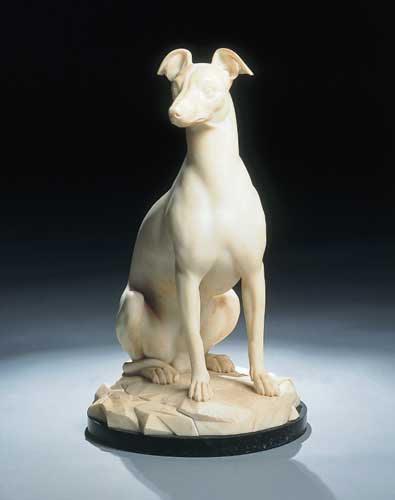Peter Turnerelli (1774-1839)
Caro, the Countess of Breadalbane's Italian greyhound
£36,000
Auction: 30 June 2001 at 12:00 BST
Description
a Carara marble statue of a seated greyhound, on a stylised rocky plinth and a circular black slate base, inscribed P. Turnerelli
65cm high
Footnote
Exhibited: The Royal Academy, London, 1811
Turnerelli exhibited 'Caro, a favorite Venetian greyhound, for the Countess of Breadalbane', at the Royal Academy in the same year as his celebrated full length statue of George III in State robes, and it was his only other submission for that year. In February of 1811 he had invoiced the 4th Earl of Breadalbane (1762-1834) for 'modelling a Sicilian Greyhound in Park Lane & workg. do. [ditto] in marble' for which he charged him the grand sum of £210. The ivy carved marble pedestal and base 'with a pivot for the dog to turn upon' which Turnerelli also supplied cost £173 5/, and was clearly a rather significant object in itself. The present vendor's mother acquired this statue at a house sale in Scotland in the 1920s or 30s and clearly remembered a pedestal which she chose not buy as it was too heavy.
'Park Lane' in Turnerelli's account refers to the Breadalbane's London house in 1811, but Caro is recorded as being in the Billiard room of Taymouth Castle, Perthshire, their magnificent Scottish seat, in an inventory undertaken by Christie's in 1863. This inventory also records busts by Turnerelli of George III, the Duke of Clarence, the Duke of Wellington and Blucher (the 1811 account was for over £900 in total). Taymouth, one of the most magnificent houses in Scotland, was the family's Scottish seat. Virtually its entire contents were dispersed in a six day sale held by Dowell's of Edinburgh in 1922 and although there is no obvious direct reference to Caro in this catalogue, there were two days of sales of uncatalogued items in the house.
Turnerelli was one of the most eminent sculptors of his age. He was born in Belfast and educated in Dublin before moving to London and enrolling at the Academy. In 1797 he was appointed to teach the Royal Princesses and in 1801 became Sculptor in Ordinary to the Royal Family; he subsequently became sculptor to HRH the Princess of Wales, as well as the Kings of France, Russia (the Czar visited his studio in 1814, ordering two busts for the Hermitage) and Portugal. Over this period Turnerelli carved portraits of most of the Royal family, including the Jubilee bust of George III in 1809, of which over eighty copies were made (one of which the Breadalbane's clearly owned), a companion bust of the Queen, and the full length statue of the King. This latter was exhibited at the RA in 1811, his only other submission that year being Lady Breadalbane's Caro.
Turnerelli exhibited extensively at the Academy throughout his career and carved portrait busts of many of the most eminent characters of his time, including William Pitt, Lord Melville, Lord Palmerston, Daniel O'Connell (of which 10,000 plaster copies are alleged to have been made), the Duke of Wellington, Lady Caroline Lamb, Sir Joseph Banks and Robert Burns, for the memorial in Dumfries. He twice refused a knighthood from the Prince of Wales, later George IV.
References: J Gilmartin 'Peter Turnerelli, Sculptor 1774-1839' Bulletin of the Irish Georgian Society 1967 pp2-19
Scottish Record Office Breadalbane MSS GD112/22/58 (1863 Inventory), GD112/20/4/12/31 (1811 Account)

